MySQL Performance: 500,000 queries per second using MySQL 5.7
[Introduction] This article provides the details of the article MySql5 7 achieves 50W queries per second and the benchmark results, explaining my early talk on Mysql Connect. Review the history of improvements to MySQL InnoDB. You can find it easily. It has never been so read-only in the stable versions of MySQL 5 and 6. This article provides details and benchmark results of the article "MySql5.7 achieves 50W queries per second", explaining my earlier talk on Mysql Connect.
Review the improvement history of MySQL/InnoDB. You can find it easily. In the MySQL 5.6 stable version, it has never been so fast in read-only. It is easy to understand and has good scalability in read-only (RO). I also look forward to it reaching a higher level in read+write (RW). (Especially when reading data is the main job of the database)

The following will explain it to you in order
In fact, there are two ways to control internal links in read-only workload in MySQL:
- Use a single table: MDL, trx_sys and lock_sys (InnoDB)
- Multiple tables: trx_sys and lock_sys (mainly InnoDB)
- Any very The workload of fast single table range testing is mainly due to locking caused by MDL linking. Multiple tables will be limited due to InnoDB internals (different tables will be protected by different MDL locks, so the link bottleneck in MDL will be reduced in this case). But again, it depends on the size of the workload - a measurement with more read-only work than usual will perform better in MySQL 5.6 (such as Sysbench OLTP_RO), while a smaller workload and faster query (such as Sysbench Point-Selects (using foreign keys to fetch a record) will make all links difficult, and can only be measured in 16-core-HT, and performs poorly in 32-core.. but any such as Point-Select The test workload will allow you to see the maximum performance possible with all MySQL internals working together (starting with the SQL parser, terminating with fetching the row value)... on your given MySQL version and given HW Depending on the configuration, this may also reach the maximum SQL queries per second (QPS) rate.
The best result we obtained on Mysql5.6 was 250,000 queries per second, which was also the best result obtained using SQL statement queries on Mysql/InnoDb during that period.
Of course, such high speed can only be achieved when using the 'read-only transaction' function (a new feature on Mysql5.6); in addition, AUTOCOMMIT=1 needs to be used, otherwise the CPU will be easily wasted on startup Transactions, commit transactions, you will actually lose the overall performance of the system.
So the first improvement introduced on Mysql5.7 is 'Auto-discovery of read-only transactions' (actually every InnoDb transaction is considered read-only until there is a DML declaration before it External) function ---, which greatly simplifies the read-only transaction function and saves users and developers time. They no longer have to manage whether to use the read-only transaction function. However, using this function you still cannot achieve the potential optimal query rate per second of Mysql, because CPU time is still wasted in the process of opening and ending status of transactions.
At the same time, Percona uses different solutions to solve the problem of "transaction list" management (TRX-list) and the slow problem of trx_sys mutual exclusion links in InnoDB. Percona's solution performs well when handling high loads of Point-Selects with transactions, but MySQL 5.7 performs mediocrely (but I won't publish the results for 5.7 because its code is not public)... So, at least I can now Do some comparisons:
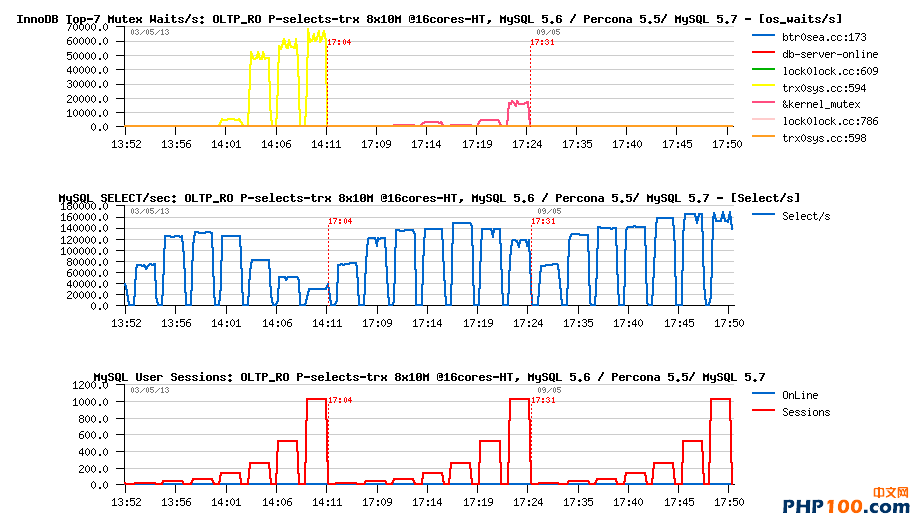 Observations:
Observations:
- 8 tables in MySQL5.6, Percona 5.5 and MySQL5.7 Use the same Roint-Select-TRX read-only test (using transactions) (2013.5 results)
- At the same time, you can also see that in the same Under the 16-core-HT configuration, we are still far from the peak result of 250,000/s.
- MySQL5.6 has extended link times in trx_sys mutual exclusion access, and the number of requests per second will be reduced since 64 users.
- Percona5.5 can maintain the load for a long time, and the requests per second only start to decrease at 512 users
- When MySQL5.7 has been maintained for a period of time, the requests per second have still not decreased (you can’t see it in this picture for more concurrent users)...
- However, it is clear that if you want to get the maximum potential query rate per second with MySQL, transactions should be avoided.
Let’s take a look at what our maximum query rate per second was in May 2013.
Tested on eight tables at the same point, but did not use MySQL5.6:
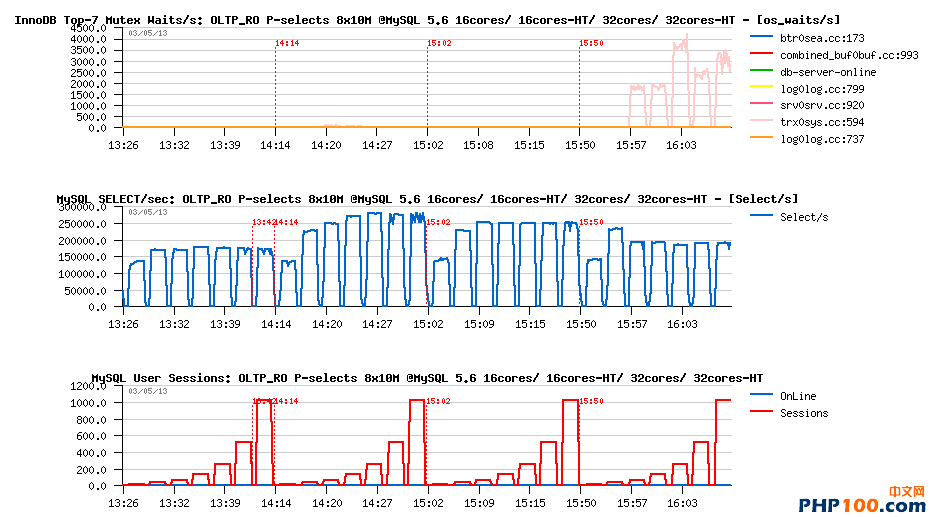
Observation:
The above test is to keep MySQL5.6 always executed on 16 cores, and then 16 cores-HT, 32 cores , 32-core-HT.
As you can see, the maximum query rate per second is greater than expected - 275,000 per second on MySQL
The maximum result has reached 16-core-HT.
However, the result on 32-core is not as good as that on 16-core-HT (due to Competition interrupts, configurations with 2 CPU threads in the same core can better manage thread competition - so the real concurrency is still saved on 16 threads instead of 32 cores)
The same test on MySQL5.7 looks very different, because the time period of lock_sys mutual exclusion link in 5.7 is already very low, and the trx_sys mutual exclusion related code also gets the first change:
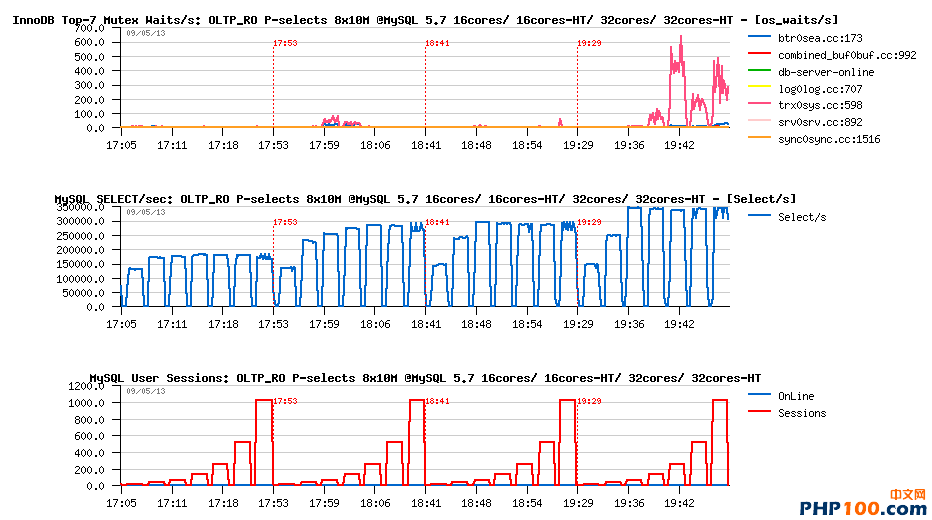
Observation results:
First of all, you can see that the performance of 5.7 under the same 16-core-HT configuration is already better than that of 5.6 After
#, there is no obvious enhancement under the 32-core configuration!
The maximum request reached 350,000/second under the 32-core-HT configuration!
From the above special (aggressive) read-only load test situation, it can be easily seen that the results we get in 32 cores are better than those in 16 , and at the same time we have not enabled hyperthreading (on 32-core-HT)... awesome! ;-)
On the other hand, it is clear that there is still room for improvement. The contention on trx_sys is still ongoing. We're not fully using the CPU power to do useful work (there are still many CPU cycles spent on lock rotation)...but the results are much better now than before, and much better than 5.6, so there is no reason to keep mining to improve In this aspect of performance, we are mainly focused on improving the performance of read and write workloads where we once spent huge amounts of space.
At the end of May, during our performance session, Sunny added several new changes to try_sys mutex contention, and since then the maximum query per second (QPS) can reach 375K ! This isn't enough of a performance improvement for 5.7, right? ;-)
At the same time, we continue to exchange opinions with the Percona team who suggest other ways to manage the TRX list. Their solution looks very interesting, but on 5.5, such code cannot show higher performance. The number of queries per second (QPS) that can be performed, and the maximum number of queries per second (QPS) that can be performed on such code on 5.6 (Percona Server 5.6 has been tested) will not be greater than on MySQL 5.6. However, the discussion brings up an interesting point: what impact does it have on read-only performance if there are some read and write workloads running at the same time? ...and, even under the same test conditions, the MySQL 5.7 code still runs significantly better, and the effect is very obvious (you can check out my analysis here, however, again, I can't show 5 during this time) .7, since its code has not yet been released to the public - perhaps in a future article)..
Since this also has an impact on any pure read and write load, so There was enough motivation to rewrite the entire TRX list related code in the way Sunnys had wanted to for a long time, however, the experience was nothing short of obsessive!
;-)) Day after day, we were pleased to see our query-per-second graph gradually getting higher and higher, until we hit the same 32-core hyper-threaded server. 440K queries can be performed per second!
The number of results obtained by Selecting 8 tables on 5.7 Development Milestone Release 2:

No explanation required ..;-))
However, there is one small oddity - we tried with Sunny to analyze all the bottlenecks and the impact of code changes through different tools. And in some tests, to my surprise Sunny observed a higher number of queries per second than I did. This "strangeness" is related to the following factors:
Under high load, the current 5.7 code runs close to the hardware limit (mainly the CPU), so every instruction is very important!
If you use a Unix socket or IP port, the difference will be very obvious!
Sysbench itself uses 30% of the CPU time, but the same test load using an older version of Sysbench (with a shorter code path) will only use 20% %CPU, the remaining 10% is used on the MySQL server.
Therefore, with the same test load, using Unix sockets instead of IP ports, and using Sysbench-0.4.8 instead of Sysbench-0.4.13, we will get every Over 500K queries per second! - Easy enough, isn't it? ;-))
Let’s compare the “before” and “after” differences
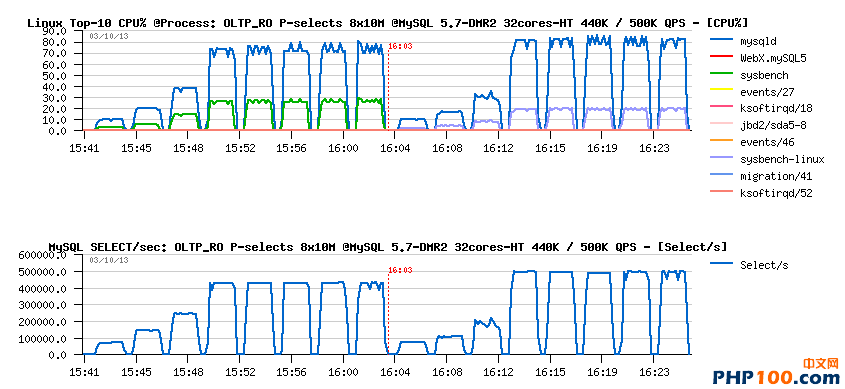
观察结果:
通过Sysbench降低了CPU的使用率。
在MySQL服务器上具有更高的CPU可用性。
我们实现了50万每秒查询。
还有什么呢?
我可能只提到:kudos Sunny和整个MySQL的开发团队;
让我们看一下现在选择8张表工作负载的情况下的最大每秒查询。
MySQL-5.7.2 (DMR2)
MySQL-5.6.14
MySQL-5.5.33
Percona Server 5.6.13-rc60.5
Percona Server 5.5.33-rel31.1
MariaDB-10.0.4
MariaDB-5.5.32
每个引擎都在以下配置下进行测试:
CPU taskset: 8核-HT,16核,16核-HT,32核,32核-HT
并发会话数:8,16,32 ... 1024
InnoDB自旋等待延时:6,96
最好的结果是来自任意两个特定的组合间的比较。通过对数据库引擎的比较,我得到了下面的一个图表,这个图表我在以前的文章中已经提到过了。
 下面是一些评论:
下面是一些评论:
对Mysql5.7的巨大差距结果不需要做过多的评论,因为这是很明显的。
那么,有趣的是基于MySQL5.5的代码库引擎没有任何的接近MySQL5.6的结果。
这已经证实了在使用MySQL5.6的代码库引擎之后,Percona Server达到了MySQL5.6的水平,然而MariaDB-10仍然还在探索的路上。
因此,毫无疑问,MySQL5.6是代码的基石!
MySQL5.7是在MySQL5.6基础上的再一次优化扩展。
具有什么样的扩展性呢?
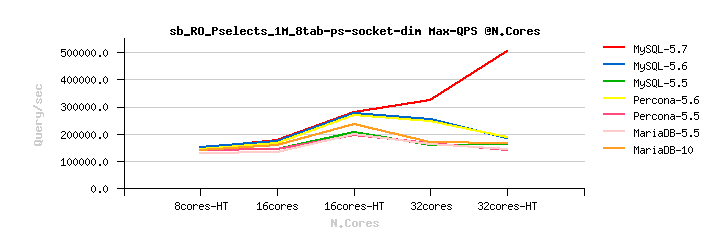
答案是简单的:MySQL5.7是唯一在此基础上进行扩展的。
如果使用ip端口和一个重量级的Sysbench-0.4.13,会得到如下的结果:
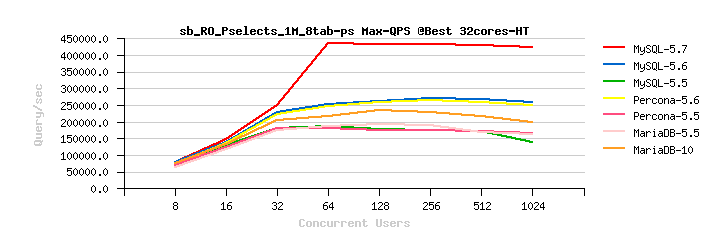
QPS只是稍微的略低一点,但是总体的趋势是完全一样的。
可扩展性也是非常的相似:

更多的结果将会出来,敬请期待;
注意:对一个单表绑定过多的工作负载是不好的:
减少InnoDB间的争论使得其他的争论更加的明显。
当负载是绑定在一张单表上时候,MDL的争论将变得更加主导。
这是预期希望的,我们在下一个DMRS上将保持不变。
还有很多挑战摆在我们面前;-)
作为参考,我上述测试的硬件配置信息如下:
Server : 32cores-HT (bi-thread) Intel 2300Mhz, 128GB RAM
OS : Oracle Linux 6.2
FS : 启用"noatime,nodiratime,nobarrier"挂载的EXT4
my.conf:
max_connections=4000 key_buffer_size=200M low_priority_updates=1 table_open_cache = 8000 back_log=1500 query_cache_type=0 table_open_cache_instances=16 # files innodb_file_per_table innodb_log_file_size=1024M innodb_log_files_in_group = 3 innodb_open_files=4000 # buffers innodb_buffer_pool_size=32000M innodb_buffer_pool_instances=32 innodb_additional_mem_pool_size=20M innodb_log_buffer_size=64M join_buffer_size=32K sort_buffer_size=32K # innodb innodb_checksums=0 innodb_doublewrite=0 innodb_support_xa=0 innodb_thread_concurrency=0 innodb_flush_log_at_trx_commit=2 innodb_max_dirty_pages_pct=50 innodb_use_native_aio=1 innodb_stats_persistent = 1 innodb_spin_wait_delay= 6 / 96 # perf special innodb_adaptive_flushing = 1 innodb_flush_neighbors = 0 innodb_read_io_threads = 4 innodb_write_io_threads = 4 innodb_io_capacity = 4000 innodb_purge_threads=1 innodb_adaptive_hash_index=0 # monitoring innodb_monitor_enable = '%' performance_schema=OFF
如果你需要的话,Linux Sysbench的二进制版本在这里:
Sysbench-0.4.13-lux86
Sysbench-0.4.8-lux86
使用UNIX socket来运行Point-Selects测试的Sysbench命令如下(在parallel中启动8个进程):
LD_PRELOAD=/usr/lib64/libjemalloc.so /BMK/sysbench-0.4.8 --num-threads=$1 --test=oltp --oltp-table-size=10000000 MySQL Performance: 500,000 queries per second using MySQL 5.7
--oltp-dist-type=uniform --oltp-table-name=sbtest_10M_$n MySQL Performance: 500,000 queries per second using MySQL 5.7
--max-requests=0 --max-time=$2 --mysql-socket=/SSD_raid0/mysql.sock MySQL Performance: 500,000 queries per second using MySQL 5.7
--mysql-user=dim --mysql-password=dim --mysql-db=sysbench MySQL Performance: 500,000 queries per second using MySQL 5.7
--mysql-table-engine=INNODB --db-driver=mysql MySQL Performance: 500,000 queries per second using MySQL 5.7
--oltp-point-selects=1 --oltp-simple-ranges=0 --oltp-sum-ranges=0 MySQL Performance: 500,000 queries per second using MySQL 5.7
--oltp-order-ranges=0 --oltp-distinct-ranges=0 --oltp-skip-trx=on MySQL Performance: 500,000 queries per second using MySQL 5.7
--oltp-read-only=on run > /tmp/test_$n.log &使用IP端口来运行Point-Selects测试的Sysbench命令如下(在parallel中启动8个进程):
LD_PRELOAD=/usr/lib64/libjemalloc.so /BMK/sysbench-0.4.13 --num-threads=$1 --test=oltp --oltp-table-size=10000000 MySQL Performance: 500,000 queries per second using MySQL 5.7
--oltp-dist-type=uniform --oltp-table-name=sbtest_10M_$n MySQL Performance: 500,000 queries per second using MySQL 5.7
--max-requests=0 --max-time=$2 --mysql-host=127.0.0.1 --mysql-port=5700 MySQL Performance: 500,000 queries per second using MySQL 5.7
--mysql-user=dim --mysql-password=dim --mysql-db=sysbench MySQL Performance: 500,000 queries per second using MySQL 5.7
--mysql-table-engine=INNODB --db-driver=mysql MySQL Performance: 500,000 queries per second using MySQL 5.7
--oltp-point-selects=1 --oltp-simple-ranges=0 --oltp-sum-ranges=0 MySQL Performance: 500,000 queries per second using MySQL 5.7
--oltp-order-ranges=0 --oltp-distinct-ranges=0 --oltp-skip-trx=on MySQL Performance: 500,000 queries per second using MySQL 5.7
--oltp-read-only=on run > /tmp/test_$n.log &
愿你有所收获,
-Dimitri
以上就是 MySQL性能:使用 MySQL 5.7 实现每秒 50 万查询的内容,更多相关内容请关注PHP中文网(www.php.cn)!

Hot AI Tools

Undresser.AI Undress
AI-powered app for creating realistic nude photos

AI Clothes Remover
Online AI tool for removing clothes from photos.

Undress AI Tool
Undress images for free

Clothoff.io
AI clothes remover

AI Hentai Generator
Generate AI Hentai for free.

Hot Article

Hot Tools

Notepad++7.3.1
Easy-to-use and free code editor

SublimeText3 Chinese version
Chinese version, very easy to use

Zend Studio 13.0.1
Powerful PHP integrated development environment

Dreamweaver CS6
Visual web development tools

SublimeText3 Mac version
God-level code editing software (SublimeText3)

Hot Topics
 1377
1377
 52
52
 12306 How to check historical ticket purchase records How to check historical ticket purchase records
Mar 28, 2024 pm 03:11 PM
12306 How to check historical ticket purchase records How to check historical ticket purchase records
Mar 28, 2024 pm 03:11 PM
Download the latest version of 12306 ticket booking app. It is a travel ticket purchasing software that everyone is very satisfied with. It is very convenient to go wherever you want. There are many ticket sources provided in the software. You only need to pass real-name authentication to purchase tickets online. All users You can easily buy travel tickets and air tickets and enjoy different discounts. You can also start booking reservations in advance to grab tickets. You can book hotels or special car transfers. With it, you can go where you want to go and buy tickets with one click. Traveling is simpler and more convenient, making everyone's travel experience more comfortable. Now the editor details it online Provides 12306 users with a way to view historical ticket purchase records. 1. Open Railway 12306, click My in the lower right corner, and click My Order 2. Click Paid on the order page. 3. On the paid page
 Windows 10 vs. Windows 11 performance comparison: Which one is better?
Mar 28, 2024 am 09:00 AM
Windows 10 vs. Windows 11 performance comparison: Which one is better?
Mar 28, 2024 am 09:00 AM
Windows 10 vs. Windows 11 performance comparison: Which one is better? With the continuous development and advancement of technology, operating systems are constantly updated and upgraded. As one of the world's largest operating system developers, Microsoft's Windows series of operating systems have always attracted much attention from users. In 2021, Microsoft released the Windows 11 operating system, which triggered widespread discussion and attention. So, what is the difference in performance between Windows 10 and Windows 11? Which
 How to check your academic qualifications on Xuexin.com
Mar 28, 2024 pm 04:31 PM
How to check your academic qualifications on Xuexin.com
Mar 28, 2024 pm 04:31 PM
How to check my academic qualifications on Xuexin.com? You can check your academic qualifications on Xuexin.com, but many users don’t know how to check their academic qualifications on Xuexin.com. Next, the editor brings you a graphic tutorial on how to check your academic qualifications on Xuexin.com. Interested users come and take a look! Xuexin.com usage tutorial: How to check your academic qualifications on Xuexin.com 1. Xuexin.com entrance: https://www.chsi.com.cn/ 2. Website query: Step 1: Click on the Xuexin.com address above to enter the homepage Click [Education Query]; Step 2: On the latest webpage, click [Query] as shown by the arrow in the figure below; Step 3: Then click [Login Academic Credit File] on the new page; Step 4: On the login page Enter the information and click [Login];
 Comparing the performance of Win11 and Win10 systems, which one is better?
Mar 27, 2024 pm 05:09 PM
Comparing the performance of Win11 and Win10 systems, which one is better?
Mar 27, 2024 pm 05:09 PM
The Windows operating system has always been one of the most widely used operating systems on personal computers, and Windows 10 has long been Microsoft's flagship operating system until recently when Microsoft launched the new Windows 11 system. With the launch of Windows 11 system, people have become interested in the performance differences between Windows 10 and Windows 11 systems. Which one is better between the two? First, let’s take a look at W
 Kirin 8000 processor competes with Snapdragon series: Who can be king?
Mar 25, 2024 am 09:03 AM
Kirin 8000 processor competes with Snapdragon series: Who can be king?
Mar 25, 2024 am 09:03 AM
In the era of mobile Internet, smartphones have become an indispensable part of people's daily lives. The performance of smartphones often directly determines the quality of user experience. As the "brain" of a smartphone, the performance of the processor is particularly important. In the market, the Qualcomm Snapdragon series has always been a representative of strong performance, stability and reliability, and recently Huawei has also launched its own Kirin 8000 processor, which is said to have excellent performance. For ordinary users, how to choose a mobile phone with strong performance has become a key issue. Today we will
 Comparison of PHP and Go languages: big performance difference
Mar 26, 2024 am 10:48 AM
Comparison of PHP and Go languages: big performance difference
Mar 26, 2024 am 10:48 AM
PHP and Go are two commonly used programming languages, and they have different characteristics and advantages. Among them, performance difference is an issue that everyone is generally concerned about. This article will compare PHP and Go languages from a performance perspective, and demonstrate their performance differences through specific code examples. First, let us briefly introduce the basic features of PHP and Go language. PHP is a scripting language originally designed for web development. It is easy to learn and use and is widely used in the field of web development. The Go language is a compiled language developed by Google.
 The local running performance of the Embedding service exceeds that of OpenAI Text-Embedding-Ada-002, which is so convenient!
Apr 15, 2024 am 09:01 AM
The local running performance of the Embedding service exceeds that of OpenAI Text-Embedding-Ada-002, which is so convenient!
Apr 15, 2024 am 09:01 AM
Ollama is a super practical tool that allows you to easily run open source models such as Llama2, Mistral, and Gemma locally. In this article, I will introduce how to use Ollama to vectorize text. If you have not installed Ollama locally, you can read this article. In this article we will use the nomic-embed-text[2] model. It is a text encoder that outperforms OpenAI text-embedding-ada-002 and text-embedding-3-small on short context and long context tasks. Start the nomic-embed-text service when you have successfully installed o
 Performance comparison of different Java frameworks
Jun 05, 2024 pm 07:14 PM
Performance comparison of different Java frameworks
Jun 05, 2024 pm 07:14 PM
Performance comparison of different Java frameworks: REST API request processing: Vert.x is the best, with a request rate of 2 times SpringBoot and 3 times Dropwizard. Database query: SpringBoot's HibernateORM is better than Vert.x and Dropwizard's ORM. Caching operations: Vert.x's Hazelcast client is superior to SpringBoot and Dropwizard's caching mechanisms. Suitable framework: Choose according to application requirements. Vert.x is suitable for high-performance web services, SpringBoot is suitable for data-intensive applications, and Dropwizard is suitable for microservice architecture.




